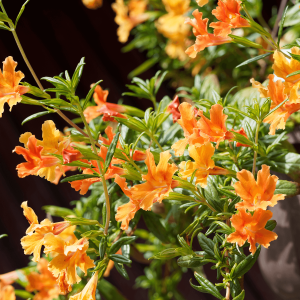The Southern Bush Monkeyflower, scientifically known as Diplacus longiflorus,
What is that- Series:
I am always amazed at the plants and flowers that grow in my yard after the winter rains.
Here is a picture of the Southern Bush Monkeyflower (Diplacus longiflorus).
The Southern Bush Monkeyflower, scientifically known as Diplacus longiflorus, is a charming and ecologically significant California native plant that graces the landscapes of the Golden State with its vibrant blooms and distinctive features. This delightful perennial wildflower, belonging to the Phrymaceae family, is a testament to the rich biodiversity and unique beauty of California’s native flora.
Description:
Standing at a height of 1 to 3 feet, the Southern Bush Monkeyflower is characterized by its slender, upright stems, which are covered in lush, dark green, lance-shaped leaves. The leaves are arranged alternately along the stem, providing a lush backdrop for the star of the show—the stunning tubular flowers.
Flowers:
The hallmark of the Southern Bush Monkeyflower is undoubtedly its striking, elongated tubular flowers. These blossoms, which appear from spring through early summer, are typically 1 to 2 inches long and exhibit a range of colors, including shades of red, orange, yellow, and occasionally pink. The corolla of the flower is often marked with intricate patterns of spots or stripes, adding to its visual appeal. This unique floral structure serves as an adaptation to attract pollinators, primarily hummingbirds, who are drawn to the nectar-rich blooms. The Southern Bush Monkeyflower’s reliance on hummingbirds for pollination is an excellent example of the intricate relationships between native plants and their coevolved pollinators.
Habitat and Distribution:
Southern Bush Monkeyflowers thrive in a variety of habitats throughout California, including chaparral, coastal sage scrub, and oak woodlands. They are most commonly found in well-drained soils in areas with plenty of sunlight. This hardy plant is well adapted to the state’s Mediterranean climate, where it often experiences long, hot, and dry summers.
Ecological Importance:
Beyond their aesthetic appeal, Southern Bush Monkeyflowers play a crucial role in California’s ecosystems. As native plant species, they provide habitat and sustenance for various wildlife, including bees, butterflies, and hummingbirds. Furthermore, they contribute to soil stability and prevent erosion in their natural habitats, helping to maintain the health and integrity of California’s ecosystems.
Cultivation:
Gardeners and conservationists alike appreciate Southern Bush Monkeyflowers for their ease of cultivation and ecological benefits. They are an excellent choice for native plant gardens, where they can attract pollinators and add a splash of color. When cultivated, they require well-drained soil and regular watering until established, after which they can thrive with minimal maintenance.
The Southern Bush Monkeyflower is a captivating native plant that embodies the spirit of California’s unique and diverse landscapes. Its vibrant tubular flowers, ecological significance, and adaptability make it a beloved addition to both natural habitats and cultivated gardens. This native wildflower serves as a reminder of the importance of preserving and celebrating California’s rich botanical heritage. Look for it toward the end of March while hiking your favorite trail this year.


